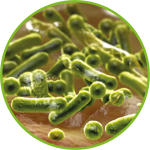Whether due to contamination or poor hygiene, an infected wound will often have malodour, pus or discoloured drainage, and is typically accompanied by pyrexia.
Wounds can become infected with Pathogens (bacteria), which prevents healing. It also increases your risk of other complications. In some cases, the infection may spread to other parts of your body through blood causing sepsis.
Anyone with suspected sepsis should be referred immediately for acute care.

Clinical signs
- Pain, redness, swelling, increased exudate, change in exudate colour, bad wound odour, increased wound temperature – (TILI score)
The clinical picture will depend upon the properties of the microbe.
What infects a wound?
- Mixed skin flora from the patient
- endogenous pathogens
- exogenous pathogens
Most infected wounds are caused by bacterial colonization, originating either from the normal flora on the skin, or bacteria from other parts of the body or the outside environment. The most common infection-causing bacteria is Staphylococcus aureus.
Assessing the risk of wound infection
Patient assessment should include the general medical condition and risk factors for wound infection. Age (e.g. neonatal and elderly patients), certain chronic medical conditions (e.g. diabetes, pulmonary disease, vascular disease), medications (e.g. oncology drugs, anti-platelet drugs, glucocorticoid steroids) and lifestyle factors (e.g. smoking, alcohol consumption) put patients with wounds at greater risk for the development of infection.
What is a Biofilm?
Biofilms will often be present in wounds with chronicity, and may be responsible for the state of persistent inflammation. Biofilms are dynamic communities of bacteria and fungi living within a protective self-secreted matrix of sugars and proteins. They can develop within 2–4 days of initial colonization, and become very tightly attached to extracellular matrix components or the wound bed, making them difficult to remove by surface irrigation or superficial debridement.
What is Therapeutic Index for Local Infection (TILI)?
A new scoring system has been created to help practitioners decide when to initiate an infection treatment. This includes assessing the wound for six different parameters:
- Erythema to surrounding skin
- Heat
- Swelling
- Pain
- Stasis
- Increased exudate and/or smell
If 5 out of 6 are present then the wound is classed as infected and an antimicrobial treatment pathway started.
Diagnosis Infection
Wound infection is diagnosed by clinical assessment of the wound and the whole patient. Swabbing a wound helps determine sensitivities or resistance to empirical treatment. Several Tools are identified to be used to diagnose infection clinically, such as TILI Score.
Treatment
The wound management plan should be tailored according to the patient’s individual situation. Perform a thorough holistic assessment of the patient’s medical history and status, and of the wound and its characteristics to determine the extent to which critical colonization or local infection is a risk.
The following precautions can help minimize the risk of developing infected wounds in at-risk patients and to minimize complications in patients already exhibiting symptoms:
- Proper wound cleansing to reduce bioburden (Debride devitalized tissue)
- Maintaining balanced moist environment
- Antimicrobial and Anti-Biofilm local Treatments
- Systemic Anti-biotics
Antibiotics, whether topical or systemic, should only be used under the explicit direction of a physician.
Prevention
Follow these steps to help keep wounds from getting infected:
- Manage Risk factors leading to Infected wounds, such medications, diseases…
- Promote Fast Healing
- Cover wounds with a dressing, change it regularly.follow the instructions from healthcare provider.
- Keep the wound clean and dry
- Wash your hands before and after you care for your wound.

